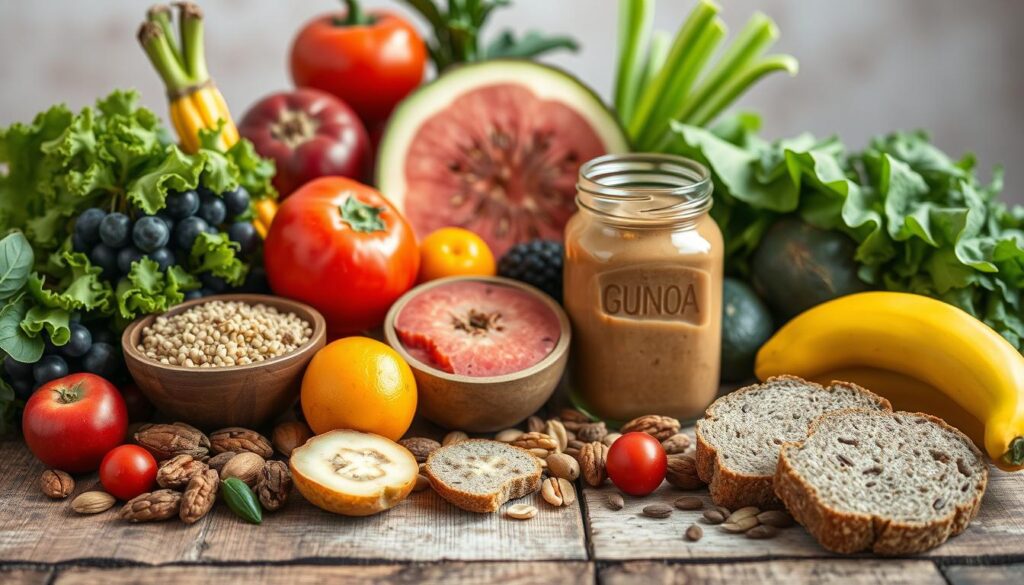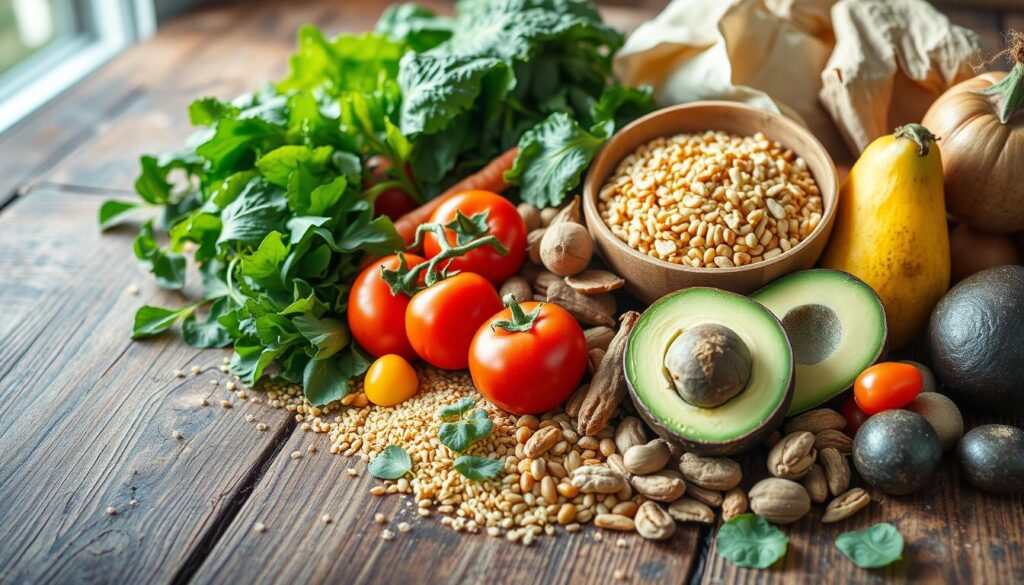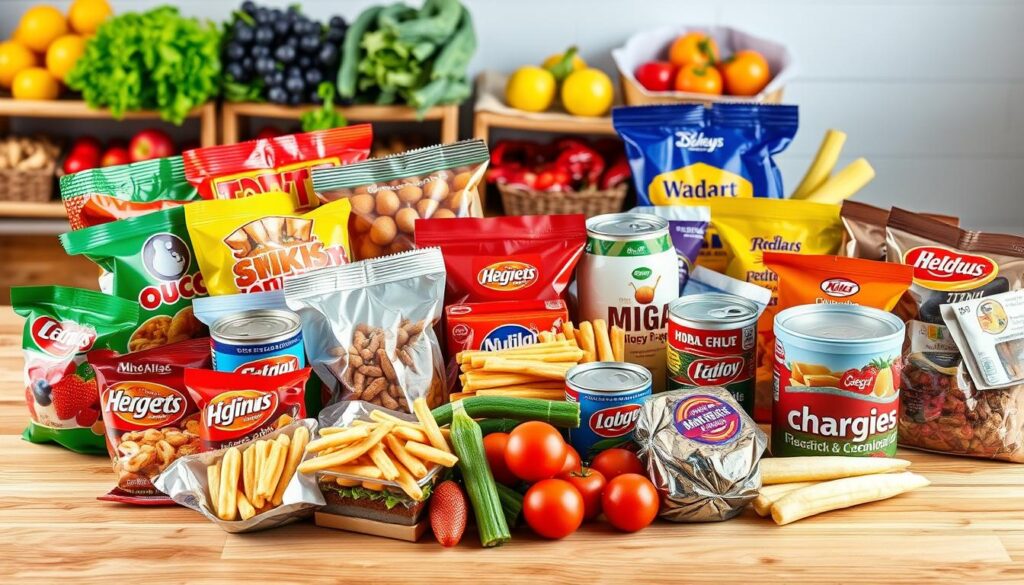In today’s fast world, many of us eat a lot of processed foods. These include canned veggies, frozen fruits, and pasteurized dairy. While some are okay, many have too much salt, sugar, and additives. Eating less of these can make you healthier.
This guide will show you how to eat less processed food. You’ll learn to choose whole foods instead. Simple changes in shopping and cooking can make a big difference. You’ll feel better and eat better.
Key Takeaways
- Processed foods can contain high levels of salt, sugar, additives, and preservatives, which can negatively impact health.
- Cutting down on processed foods is a key dietary recommendation for improved overall health and well-being.
- Incorporating more whole, unprocessed foods like fruits, vegetables, and whole grains can provide a range of nutritional benefits.
- Meal planning and preparation strategies can help reduce reliance on fast food or frozen convenience meals.
- Making gradual, sustainable changes to your eating habits can lead to long-lasting improvements in your health and lifestyle.
Understanding Processed Foods and Their Impact on Health
Many people eat a lot of processed foods today. These include things like canned veggies and frozen fruits. But, eating too much of the bad stuff can harm our health.
What Qualifies as Processed Food?
Processed foods are foods that have been changed from their natural state. This can happen through adding ingredients or preservatives. Some foods are only slightly changed, while others are very different.
The Difference Between Minimally and Ultra-Processed Foods
Minimally processed foods, like bagged salads, are changed a little. They keep their nutrients and last longer. Ultra-processed foods, however, have weird ingredients like cellulose powder. They are often full of bad stuff like fat, sugar, and salt.
Health Risks of Excessive Processed Food Consumption
Eating too much of the bad stuff can lead to serious health problems. These include breast cancer, heart disease, weight gain, obesity, and type 2 diabetes. Foods high in sugar, bad fats, and salt are especially bad.
“Ultra-processed foods can contribute to 25–60% of a person’s daily energy intake globally.”
It’s important to know the difference between good and bad processed foods. This helps us make better choices. By choosing whole foods over processed ones, we can stay healthier.
Benefits of Reducing Processed Food Intake
Eating more nutrient-dense foods and natural ingredients is good for you. It helps you feel better and stay healthy. Eating less processed food can make you feel great.
One big plus is it helps you keep a healthy weight. Nutrient-dense whole foods have fewer calories. They also make you feel full, so you don’t eat too much.
Also, eating natural foods can make you happier and sleep better. They are full of good stuff that keeps your heart healthy. This helps fight off sickness and keeps your body working right.
Also, eating less processed food is good for your gut. Nutrient-dense foods feed the good bacteria in your stomach. This keeps your gut healthy and working well.
“Eating a diet high in ultra-processed foods has been shown to contribute to health issues due to excessive calorie, fat, salt, and sugar consumption.”
Switching to whole, unprocessed foods is a smart move. It brings many health benefits and helps your body. This simple change can really improve your health.
How to Eat Less Processed Foods: Essential Steps to Get Started
Start by cooking more at home. This means eating home cooking, mindful eating, and healthy food choices. Small changes in your kitchen and shopping can help. You’ll eat less processed food and feel better.
Kitchen Organization Tips
Make your kitchen better for healthy cooking. Put things you use often in easy spots. Fill your kitchen with whole foods like fruits and grains.
Clear off counters and set up areas for cooking. This keeps your kitchen clutter-free and ready for cooking.
Smart Shopping Strategies
Shop the outer aisles for fresh foods. Choose fruits, veggies, and lean proteins. Read food labels to avoid bad stuff.
Try to avoid the inner aisles. They have more ultra-processed foods.
Meal Planning Basics
Plan your meals to avoid processed convenience foods. Set aside time each week to plan and shop. This way, you always have healthy food ready.
Follow these steps to eat less processed food. You’ll enjoy a healthier, more mindful, home-cooked diet.
Smart Food Swaps for Healthier Eating
Making small changes to your diet can really help your health. Instead of eating lots of processed foods, try healthier options. These swaps can cut down on bad stuff and add more good stuff to your meals.
Start with breakfast. Swap sugary cereals for oatmeal with fruit. Choose brown rice over white rice. Go for whole grain bread and pasta instead of the regular kind. Homemade salad dressings with olive oil and vinegar are better than store-bought ones.
For snacks, pick fresh fruits, carrot sticks, or nuts over chips or cookies. Drink water with fruit or unsweetened tea instead of sugary drinks. These healthy alternatives are tasty and give you important nutrients.
By making these whole grain products and fresh produce swaps, you’re on the path to a better diet. Small steps can lead to big health gains.
“The key to a healthier diet is not about perfection, but progress. Embrace the simple swaps that work best for you and your lifestyle.”

Meal Prep Strategies for Success
Meal prepping changes the game for healthy eating. It cuts down on processed foods and saves money. Spend a little time each week to prep meals. This way, you always have healthy food ready, saving time and money.
Let’s look at some great ways to prep meals. These tips will help you reach your goals in meal planning, food prep, and healthy eating.
Time-Saving Preparation Techniques
Streamlining meal prep is key. Chop veggies, cook grains, or prep proteins ahead of time. This makes daily meals quicker and easier to stay healthy.
Storage Solutions for Fresh Foods
Good storage keeps food fresh longer. Use quality containers like glass or BPA-free plastic. This helps keep your food fresh and cuts down on waste.
Batch Cooking Guidelines
Batch cooking is a big help. Make big batches of soups, stews, and casseroles. This fills your fridge and freezer with easy meals. Cool food fast, portion it out, and label it well for later use.
Using these strategies boosts your meal prep. A little time upfront leads to a stocked kitchen, healthy meals, and a smoother day. Start small and find what works for you.
Discover the Sumatra Slim BellyTonic, a powerful supplement for weight loss
Reading Food Labels and Making Informed Choices
Understanding food labels is key to healthier eating. Start by checking the first three ingredients. They are the biggest part of the product. Watch out for foods high in added sugars, sodium, and saturated fats. These can harm your health.
Choose foods with whole ingredients and avoid long lists of additives. Compare labels to find the best options. Remember, serving sizes matter. They affect the calories and nutrients you get.
| Nutrient | What to Look For |
|---|---|
| Calories | Think about the serving size and total calories. A single serving of lasagna has 280 calories. The whole package has 1,120 calories. |
| Sodium | Choose foods with less than 20% Daily Value (DV) of sodium. One serving of lasagna has 37% DV, which is too high. |
| Saturated Fat | Look for items with less than 5% DV of saturated fat. Americans often eat too much, which can harm the heart. |
| Added Sugars | Avoid foods with a lot of added sugars. They can lead to weight gain and health issues. Added Sugars include sucrose, dextrose, and syrups. |
The % Daily Value (%DV) shows how much of a nutrient a serving has. It helps you know if you’re getting enough or too much. Remember, 5% DV or less is low, and 20% DV or more is high.
By knowing nutrition facts and ingredient lists, you can make better choices. This helps you eat foods that support your health and wellness goals.
“Choosing foods with fewer ingredients and recognizable, whole-food sources can help you minimize your intake of processed items and promote better health.”
Building a Whole Foods Kitchen Essentials
Starting a whole foods lifestyle means having the right stuff in your kitchen. Fill your pantry and fridge with good, simple foods. This way, you can make healthy meals at home and avoid bad processed foods. Let’s look at what you need for a great whole foods kitchen.
Pantry Staples List
First, build a strong pantry base. Key items include:
- Whole grains (brown rice, quinoa, oats, whole wheat pasta)
- Legumes (dried beans, lentils, chickpeas)
- Nuts and seeds (almonds, walnuts, chia, flax)
- Healthy oils (extra virgin olive oil, avocado oil)
- Spices and herbs (sea salt, black pepper, garlic, basil, oregano)
- Canned goods (diced tomatoes, tuna, salmon, beans)
Essential Kitchen Tools
Having the right tools makes cooking easier. Get these essentials:
- A good chef’s knife for chopping and slicing
- A food processor or blender for sauces and dips
- Reusable containers to keep food fresh
Fresh Produce Storage Tips
Storing food right keeps it fresh longer. Here’s how to keep your produce great:
| Produce Item | Storage Tip |
|---|---|
| Leafy Greens | Store in a sealed container or plastic bag with a paper towel to absorb excess moisture. |
| Berries | Keep in the refrigerator in a shallow container, rinsing just before use. |
| Avocados | Store at room temperature until ripe, then refrigerate to slow down the ripening process. |
With whole foods, tools, and good storage, you’re set for healthy meals. Enjoy making your own food at home.

Common Challenges and Solutions
Switching to healthier foods can be tough. But, with smart strategies, you can beat these hurdles. This way, you’ll start habits that help you make lasting lifestyle changes.
Many of us struggle with not having enough time. It’s tempting to grab quick, packaged foods. To overcome this, try cooking meals ahead of time. Spend a few hours on the weekend cooking and making snacks. This saves you time later in the week.
It’s also hard to resist cravings for foods we love. These cravings can be strong, especially if we’ve eaten them for years. To combat this, find healthy foods that taste good. Try making your own snacks or new recipes with fresh ingredients.
Finding good alternatives to processed foods can be hard. To address this, fill your kitchen with whole foods. This includes fruits, veggies, whole grains, and lean proteins. Visit local farmers’ markets or specialty stores for new, unprocessed foods.
Remember, overcoming obstacles and developing healthy habits takes time. Be kind to yourself and celebrate small wins. With practice, eating less processed food will get easier. It will also make you healthier and happier.
Conclusion
Reducing processed foods is a big step towards better health. Focus on whole foods and plan your meals. This helps you eat better and stay healthy.
It’s okay to have treats sometimes. The main goal is to make healthy habits last. This way, you can feel better and avoid serious diseases.
Start small to change how you eat. Use the tips from this guide to make progress. Be kind to yourself and celebrate your wins. Your future self will be grateful for your healthy choices.


A Life-Changing Experience with This Weight Loss Supplement (Nagano Tonic)
I’ve always struggled with finding a weight loss solution that actually works for me. Like many, I’ve tried numerous diets, exercise routines, and supplements over the years—some worked for a short time, but nothing ever gave me long-term results. That was until I decided to try the weight loss supplement I found : Link to the Supplement.
From the moment I started using it, I noticed a difference. Not only did I feel more energized, but my cravings also became more manageable. The best part? I started seeing results much quicker than I anticipated! Over the course of just a few weeks, I noticed a significant reduction in belly fat and overall weight loss that I hadn’t been able to achieve before.
What makes this supplement stand out from all the others I’ve tried is how it supports me in my daily routine without any jitters or energy crashes. I’m able to stay focused and motivated, which has made it easier to stay on track with my diet and exercise plan.
This product truly exceeded my expectations, and I feel more confident and healthier than ever before. If you’re struggling with your weight loss journey like I was, I highly recommend giving this supplement a try. It’s been a game-changer for me, and I’m sure it can work wonders for you too!
Contant Them on email .. tonicnagano50@gmail.com
I’ve tried so many weight loss products over the years, but nothing worked like this supplement! Since I started using it, I’ve noticed a big difference in my energy levels and appetite control. In just a few weeks, I’ve lost weight and feel so much better. It’s been easy to stick with, and the results speak for themselves. Highly recommend this to anyone looking to make a real change!
This Nagano Tonic has been amazing! In just a few weeks, I’ve lost weight, feel more energized, and my cravings are under control. Highly recommend it!
Thats the link to purchase http://surl.li/iasppy